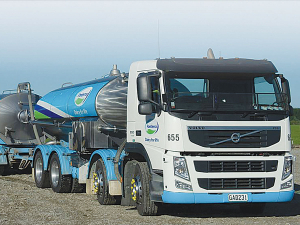Fonterra slashes forecast milk price, again
Fonterra has slashed another 50c off its milk price forecast as global milk flows shows no sign of easing.
 Fonterra says customers and consumers have increasing expectations about the environmental impact their food leaves.
Fonterra says customers and consumers have increasing expectations about the environmental impact their food leaves.
Fonterra says its global customers are seeking products perceived to be more environmentally friendly.
And customers are snubbing suppliers who do not meet their sustainability requirements.
“There are increasing expectations from customers and consumers about where their food comes from and the environmental impact it leaves,” Fonterra says.
The co-operative made the comments while responding to questions from the Fonterra Co-operative Council, which represents its shareholders.
The council released its quarterly update to members last month. The nine-page report looks at Fonterra’s performance and also contained Fonterra’s board’s response to three questions from the council.
One of the questions related to new and emerging challenges facing Fonterra and how the co-operative is handling these challenges.
Fonterra says it is making continued progress on its operational response – manufacturing decarbonisation plan and water treatment and efficiency upgrades.
It is also increasing R&D to look for solutions for the on-farm methane challenge.
It also continues to support and recognise farmers in managing their sustainability performance through the Co-operative Difference framework.
"Broadly, these challenges will be responded to by staying on strategy, focusing on our strengths and what's within our control," the co-op says.
"The strategy refresh recognises increasing consumer expectations around environmental performance and the increase in alternatives available to them.
"It also acknowledges the fast pace of change in people's nutrition consumption trends."
The co-operative is also maintaining a diversified portfolio in markets around the world.
Strategy Gets A Kick
Fonterra shareholders are strongly backing the co-operative’s new strategy to enhance the value of New Zealand milk.
The Fonterra Co-operative Council wrote to the board in September commending it for the recent progress.
“Our research indicates that 82% of our members are more comfortable with the overall direction of our co-op than they were two to three years ago,” the letter says.
“Complementing that data, we have accumulated considerable feedback that members are very supportive of the transformation in culture they have perceived within Fonterra.
“Our members have indicated they are comfortable with the new strategic focus on enhancing the value of New Zealand milk.”
Farmer confidence has taken a slight dip according to the final Rabobank rural confidence survey for the year.
Former Agriculture Minister and Otaki farmer Nathan Guy has been appointed New Zealand’s Special Agricultural Trade Envoy (SATE).
Alliance Group has commissioned a new heat pump system at its Mataura processing plant in Southland.
Fonterra has slashed another 50c off its milk price forecast as global milk flows shows no sign of easing.
Meat processors are hopeful that the additional 15% tariff on lamb exports to the US will also come off.
Fears of a serious early drought in Hawke’s Bay have been allayed – for the moment at least.
President Donald Trump’s decision to impose tariffs on imports into the US is doing good things for global trade, according…
Seen a giant cheese roll rolling along Southland’s roads?